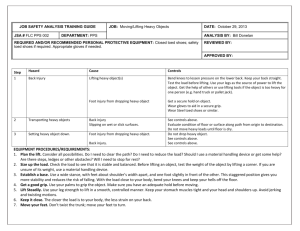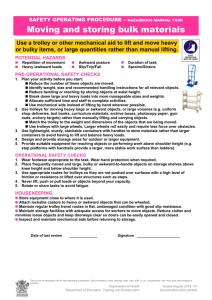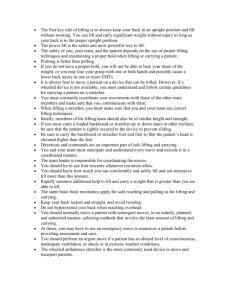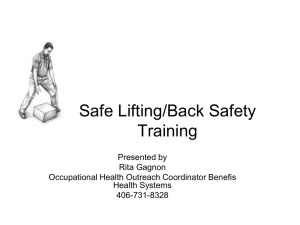Manual Handling Summary
advertisement
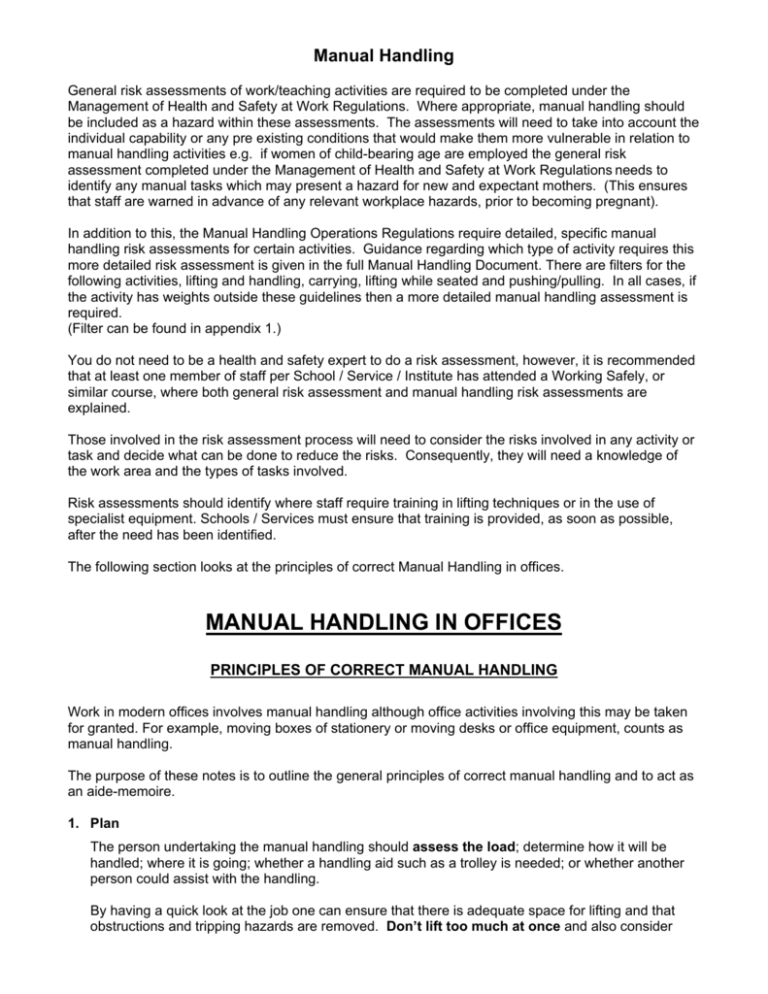
Manual Handling General risk assessments of work/teaching activities are required to be completed under the Management of Health and Safety at Work Regulations. Where appropriate, manual handling should be included as a hazard within these assessments. The assessments will need to take into account the individual capability or any pre existing conditions that would make them more vulnerable in relation to manual handling activities e.g. if women of child-bearing age are employed the general risk assessment completed under the Management of Health and Safety at Work Regulations needs to identify any manual tasks which may present a hazard for new and expectant mothers. (This ensures that staff are warned in advance of any relevant workplace hazards, prior to becoming pregnant). In addition to this, the Manual Handling Operations Regulations require detailed, specific manual handling risk assessments for certain activities. Guidance regarding which type of activity requires this more detailed risk assessment is given in the full Manual Handling Document. There are filters for the following activities, lifting and handling, carrying, lifting while seated and pushing/pulling. In all cases, if the activity has weights outside these guidelines then a more detailed manual handling assessment is required. (Filter can be found in appendix 1.) You do not need to be a health and safety expert to do a risk assessment, however, it is recommended that at least one member of staff per School / Service / Institute has attended a Working Safely, or similar course, where both general risk assessment and manual handling risk assessments are explained. Those involved in the risk assessment process will need to consider the risks involved in any activity or task and decide what can be done to reduce the risks. Consequently, they will need a knowledge of the work area and the types of tasks involved. Risk assessments should identify where staff require training in lifting techniques or in the use of specialist equipment. Schools / Services must ensure that training is provided, as soon as possible, after the need has been identified. The following section looks at the principles of correct Manual Handling in offices. MANUAL HANDLING IN OFFICES PRINCIPLES OF CORRECT MANUAL HANDLING Work in modern offices involves manual handling although office activities involving this may be taken for granted. For example, moving boxes of stationery or moving desks or office equipment, counts as manual handling. The purpose of these notes is to outline the general principles of correct manual handling and to act as an aide-memoire. 1. Plan The person undertaking the manual handling should assess the load; determine how it will be handled; where it is going; whether a handling aid such as a trolley is needed; or whether another person could assist with the handling. By having a quick look at the job one can ensure that there is adequate space for lifting and that obstructions and tripping hazards are removed. Don’t lift too much at once and also consider whether an item can be broken up into smaller loads e.g. dividing up a microcomputer into monitor and CPU. If long lifts are proposed then rest part way. If unsure about load, gauge weight by applying force gradually at one edge of load and gently rock load - if this results in strain then stop since it is likely that the task is not within your capability. 2. Lifting technique The best handling technique involves suitable balance and avoidance of unnecessary bending, twisting and reaching. Place the feet apart giving a balanced and stable base for lifting with one leg positioned forward of the other and with the 'leading' leg pointing in direction of travel and as far forward as is comfortable (easier if not wearing tight clothing). Bend knees so can easily and comfortably grasp load. Grasp with palms rather than fingers and keep arms close to body allowing whole body to support load. 3. Lifting manoeuvre A person undertaking a lift should lift slowly, smoothly, without jerking and avoiding bending of the lower back. It is important to have the centre of gravity of the load close to the body to prevent excessive stress of the back and to make the strongest muscles of the arm available to hold the load and using the leg muscles to lift the load. If a close approach to the load is not possible then try sliding it towards you before attempting to lift it. If you feel excessive strain then slowly, lower the load and seek help. Do not carry the load over excessive distances. If this is unavoidable then take short rest breaks. Keep heaviest side of load (e.g. as with computers) close to body. 4. Recovery Time Most manual handling in offices will be intermittent in nature but if it is prolonged then this activity should be done in conjunction with alternative lighter tasks that allow the active muscles to recover. 5. Team Lifting Occasionally tasks such as moving desks are best done as a team (2 person) lift. Note before lifting you should remove drawers since this can substantially affect the weight of the load. Lifting partners should be of similar height and build, and one should act as team leader to coordinate the lift. These steps are outlined in the diagram below. Alternatively if the task is considered too difficult for office staff, for example in excess of the guideline weights for lifting given in filter then you should arrange for a detail manual handling assessment or for it to be done by the Estates 'Heavy Gang' who may be contacted on 35945 or Bretton Ext. 32177. REMEMBER: IF YOU FEEL EXCESSIVE STRAIN WHEN LIFTING ETC. THEN LOWER THE LOAD AND SEEK HELP PLAN THE LIFT LIFTING TECHNIQUE FEET POSITION POSTURE OVER LOAD GET A SECURE GRIP LIFTING MANOEUVRE SMOOTH LIFT LIFT CLOSE TO BODY RECOVERY TIME Î Í Appendix 1 Manual Handling Filter 1 Each box in the diagram contains a guideline weight for lifting and lowering in that zone. The diagram enables the assessor to take into account the vertical and horizontal position of the hands as they move the load. As can be seen from the diagram, the guideline weights are reduced if handling is done with arms extended, or at high or low levels, as that is where injuries are most likely. For example, the filter indicates that 95% of women will be able to safely lift an object which weighs 16 kg from a shelf at waist height and move it to another shelf at waist height, provided the load is kept within close reach. Twisting Twisting (i.e. moving the upper body while keeping the feet static) should be avoided, wherever possible, by moving the feet. However, if twisting cannot be avoided then the weights in filter 1 would need to be reduced as shown below: Twisting Fig 2 (Ref. 2) Table 1: If the handler twists through (from the front) Filter 1 Guideline figures should be reduced by. (see Fig 2) 45º 90º 10% 20% Another factor which may necessitate the need for a more detailed assessment is if the operation involves repetitive twisting/stooping. (Stooping involves bending forward from the waist and should be avoided, wherever possible, by bending the knees.) Guidelines for Carrying The guidelines in Filter 1 also apply to carrying operations, where the load is held against the body and carried no further than about 10 m without resting. A more detailed assessment is required if the load is carried further than 10 m without resting or the hands are below knuckle height or above elbow height. Filter 2: Guidelines for Handling whilst Seated Filter 3: Guidelines for Pushing/Pulling For pushing and pulling operations (whether the load is slid, rolled or supported on wheels) the guideline figures assume the force is applied with the hands between knuckle and shoulder height. It is also assumed that the distance involved is no more than 20 metres. If these assumptions are not met, a more detailed risk assessment is automatically required. Table 2: Guideline figure for stopping or starting a load Guideline figure for keeping the load in motion Men Women 20 kg on a trolley 15 kg on a trolley this equates to around 200 newtons* this equates to around 150 newtons* 10 kg on a trolley 7 kg on a trolley this equates to around 100 newtons* this equates to around 70 newtons* (* A newton is defined as the amount of force required to accelerate a mass of one kilogram at a rate of one metre per second squared) In order to give an indication of how the above can be calculated, the amount of force that needs to be applied to move a load over a flat, level surface using a well-maintained handling aid is at least 2% of the load weight. E.g. if the load weight is 400 kg then the force needed to move the load is 8 kg. However, it should be noted that on an uneven surface, the force needed to start moving could increase to 10% of the load weight.

